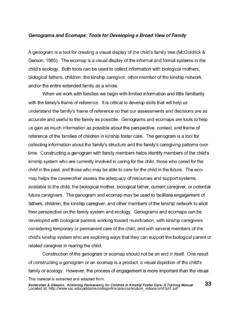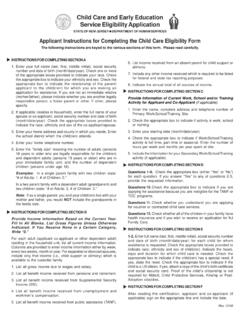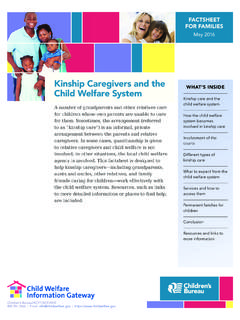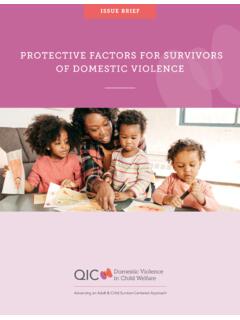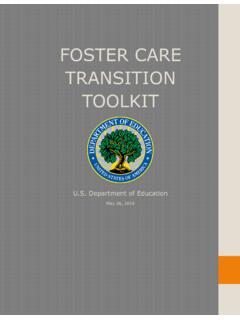Transcription of Parent-Child Interaction Therapy: A Primer for Child ...
1 Children s Bureau/ACYF/ | Email: | 2019 WHAT S INSIDEO verviewTarget populationKey componentsConsiderations when using PCIT with Child welfare populationsBenefits What to look for in a PCIT therapistConclusionAdditional resourcesReferencesParent- Child Interaction Therapy: A Primer for Child Welfare ProfessionalsParent- Child Interaction therapy (PCIT) is a family-centered treatment approach for children ages 2 7 with disruptive behavior and has also been used with abused and at-risk children ages 2 12. It is also an appropriate therapy for all caregivers birth parents, adoptive parents, or foster or kin caregivers . During PCIT, parents learn strategies that will enhance the parent- Child relationship and promote positive behaviors in children. To achieve this goal, they also interact with their Child while simultaneously receiving coaching from the PCIT therapist. Research has shown that, because of PCIT, parents learn more effective parenting techniques, the behavior problems of children decrease, the quality of the parent- Child relationship improves, and risk for Child maltreatment is reduced.
2 This factsheet is intended to help Child welfare professionals gain a better understanding of PCIT, including which clients should be referred for PCIT, how it is implemented, and resources for additional application of PCIT in Child welfare is its inclusion in foster parent training. Child behavior problems are a risk factor for foster care placement instability (Fisher, Stoolmiller, Mannering, Takahashi, & Chamberlain, 2011), and PCIT can provide valuable skills foster parents can use to help alleviate these PopulationPCIT has been successfully used or adapted for a wide range of Child and caregiver populations. Children typically are ages 2 7, but the age range can be increased for Child welfare-involved children when ineffective parenting skills, rather than the Child s disruptive behavior, are the referring concern. (See the Considerations When Using PCIT With Child Welfare Populations section of this factsheet for more information.)
3 Examples of Child populations who have benefited from PCIT include those with developmental delays, separation anxiety, and histories of Child maltreatment (Wilsie, Campbell, Chaffin, & Funderburk, 2017). Additionally, foster, adoptive, and kinship caregivers are all appropriate recipients of PCIT. PCIT has been successfully used with diverse racial and cultural PCIT is very effective in addressing certain types of problems, there are limitations to its use. For the following populations, PCIT may not be appropriate, or specific modifications to treatment may be needed: Parents who have limited or no ongoing contact withtheir Child Parents with serious mental health problems thatprevent active participation in treatment, such asauditory or visual hallucinations or delusions, or activesubstance use disorders Parents who are hearing impaired and would havetrouble using the earpiece, or parents who havesignificant expressive or receptive language deficits Sexually abusive parents or parents engaging insadistic physical abuseOverview PCIT is a behavioral parent training approach that was introduced in the 1970s to treat young children (generally ages 2 7) with externalizing behavior problems.
4 It has since been successfully delivered to support families of children who have experienced or are at risk of experiencing maltreatment (Thomas & Zimmer-Gembeck, 2012) as well as children exhibiting internalizing behavior problems (Osofsky, Stepka, & King, 2017).1 PCIT addresses negative parent- Child Interaction patterns that can contribute to problem behaviors in young children. What sets PCIT apart from other parent training approaches is the treatment of both the parent and Child together, coupled with live coaching. (For more information, see the Key Components section of this factsheet.)PCIT addresses many of the complex factors that can contribute to negative parenting or parent- Child relationships. Parents who are abusive, or at risk for being abusive, often interact in negative ways with their children; use harsh, ineffective, and inconsistent discipline strategies; and rely too much on punishment (rather than giving positive attention to desired behaviors).
5 Children in these families may be temporarily compliant due to the sporadic harsh discipline but also learn to be defiant or noncompliant overall due to inconsistent limit setting, which can create a negative cycle of behaviors by both the parent and Child (Kennedy, Kim, Tripodi, Brown, & Gowdy, 2016). This cycle of negative behaviors can escalate to the point of severe physical punishment and physical abuse. PCIT helps by encouraging positive interactions between parents and children and by training parents how to implement consistent and nonviolent discipline techniques when children act out. Children, in turn, respond to these healthier relationships and interactions with more positive behaviors. 1 Externalizing behavior problems are those directed outward toward other people or things, such as aggressive actions, disobedience, or being disruptive. This is in contrast to internalizing behavior problems, such as anxiety or depression, which are directed inward or kept inside.
6 Parent- Child Interaction Therapy: A Primer for Child Welfare ProfessionalsThis material may be freely reproduced and distributed. However, when doing so, please credit Child Welfare Information Gateway. This publication is available online at 2019htuarbepa0suh:2 2019hdr1lebrhFbslrff0sue1f3 This material may be freely reproduced and distributed. However, when doing so, please credit Child Welfare Information Gateway. This publication is available online at become more frequent in the mental health field, and at least one study has shown that delivering PCIT using real-time video teleconferencing holds promise (Comer et al., 2017).Phase 1: Child -Directed InteractionThis phase emphasizes building a nurturing relationship and secure bond between the parent and Child . During CDI sessions, the parent follows the Child s lead in a play situation while being coached by the therapist. In particular, parents are encouraged to use skills represented in the acronym PRIDE: Praise: Provide specific praise for the Child sappropriate behavior ( , saying, Good job cleaningup your crayons!)
7 To encourage the behavior andmake the Child feel good about his or her relationshipwith the parent Reflection: Repeat and build upon what the Child saysto show that the parent is listening and to encourageimproved communication Imitation: Mimic what the Child is doing, which showsapproval and helps teach the Child how to play withothers Description: Describe the Child s activity ( , You rebuilding a tower with blocks. ) to demonstrate interestand strengthen mutual play skills Enjoyment: Be engaged and authentic in the playinteractionThe therapist guides parents to use selective attention giving full attention to desirable behaviors ( , sharing) and withholding attention from unwanted or annoying behaviors ( , rudeness). For example, if a Child is cleaning up toys by slamming them into the box while loudly complaining, the parent could either give attention to the Child s positive act of cleaning up the toys ( , Thanks for picking up even though it would be more fun to keep playing.)
8 Or to the bad attitude ( , Why can t you be nice with the toys? Stop banging! ). If the behaviors are destructive or dangerous, however, play is briefly halted. The therapist also teaches the parents to avoid directive play, questioning the Child , and criticisms or negative ComponentsPCIT is typically provided in 10 20 weekly sessions, with an average of 15 sessions. Each session lasts about 1 to hours. Occasionally, additional treatment sessions are added as needed. The PCIT curriculum uses a two-phase approach: Child -directed Interaction (CDI), which focuses on relationship enhancement, and parent-directed Interaction (PDI), which focuses on effective discipline techniques. Each phase typically begins with one parent-only session for orientation to the approach followed by multiple sessions in which the therapist coaches the parent to master the targeted skills during interactions with the Child . While many other treatment approaches target either parents or children, PCIT focuses on changing the behaviors of both the parent and Child together.
9 Parents learn to model positive behaviors that children can learn from and are trained to better respond to their children s behavioral or emotional difficulties. PCIT also incorporates live coaching, in which the therapist typically observes the parent- Child interactions from behind a one-way mirror while communicating with the parent, who wears a small wireless earpiece. (Although not optimal, clinicians who do not have access to a one-way mirror or earpiece may provide services using in-room coaching or other methods.) The live coaching allows the therapist to provide immediate feedback, including support, guidance, and encouragement, to parents regarding specific relationship-building and discipline skills learned during PCIT , the therapist uses a combination of observational and standardized assessment measures to assess parent- Child interactions, Child behaviors, parental perception of stress related to being a parent, and parents perceptions of the difficulty of their Child s behaviors before, during, and after treatment.
10 The therapist conducts a brief assessment at every session to determine progress and set goals for that can be delivered effectively in either a clinic setting or at home (Fowles et al., 2018). Additionally, providing services through remote technologies ( , the internet) 2019htuarbepa0suh:2 2019hdr1lebrhFbslrff0sue1f4 This material may be freely reproduced and distributed. However, when doing so, please credit Child Welfare Information Gateway. This publication is available online at Because the focus of the treatment typically is on the parent rather than the Child in cases involving a parent who is a perpetrator, PCIT with these families can be adapted to include children up to age 12 (rather than age 7), which does not appear to affect parent outcomes (Wilsie et al., 2017). Age-related adaptations include adjusting the types of discipline discussed with the parents and increased inclusion of the Child in explaining treatment goals and practice.










